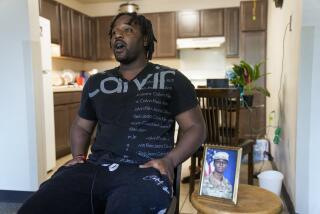Hero Recalls Shock of 1st U.S.-N. Korea Fight
- Share via
WASHINGTON — If anyone would remember the U.S. Army’s shocking first encounter with North Korean troops on July 5, 1950--10 days into the Korean War--it would be Charles “Brad” Smith.
He was there.
As a lieutenant colonel commanding Task Force Smith, a 400-man team fielded from ill-equipped and ill-prepared occupation troops in Japan, Smith witnessed the desperation of the moment on that rainy day near Suwon, South Korea.
“ ‘Here we are at the beginning of another war’ was the thought that went through my mind,” said the retired brigadier general who had been present in Hawaii when Japan bombed Pearl Harbor nine years earlier.
On Wednesday, 84-year-old Smith stood erect and square-jawed among the fields of white grave markers at Arlington National Cemetery to commemorate the sacrifices made by the soldiers of Task Force Smith. Under a gray sky, he joined 31 other surviving members of his unit, as well as Gen. Eric Shinseki, the Army’s chief of staff, and other Army leaders in laying a wreath at the Tomb of the Unknowns.
Smith recalled that when President Harry S. Truman authorized Gen. Douglas MacArthur on June 30, 1950, to send U.S. ground forces under his command in Japan to meet the invading North Korean forces south of Seoul, “the general feeling was, if the Americans show up, the North Koreans will turn tail.”
The unfortunate surprise was that the North Koreans, in columns of Russian-supplied T-34 tanks, not only swept through Task Force Smith’s blocking positions but inflicted heavy casualties as they rumbled south to Osan and beyond--an advance that was not stopped until early August at the Pusan perimeter.
Smith’s men fired bazookas and 75-millimeter recoilless rifles at 33 advancing North Korean tanks, but to little effect. The U.S. Army had developed a 3.5-inch rocket launcher capable of penetrating North Korean armor, but none were available in South Korea.
“We held them up for seven hours,” Smith recalled, by drawing the tanks off the main road into firing positions.
“By the time I ordered a withdrawal, we were down to about two clips of ammunition per rifleman,” he said, and forced to retreat through rice paddies, leaving weapons behind. “Some men took off their shoes because it was easier to walk through the ooze of a rice paddy with shoes off. It was a disaster.”
On the morning of July 6, after his makeshift battalion had to withdraw toward Osan, Smith could account for only 185 of his 400-plus men, members of the 1st Battalion, 21st Infantry Regiment of the 24th Infantry Division and the 52nd Field Artillery Battalion. Among the losses was the first U.S. soldier killed in the war.
In today’s Army, the rout of Task Force Smith is often cited as an example of the disastrous consequences of failing to keep the military modernized in arms and fully trained for short-notice combat.
Smith, while acknowledging that his men faced a mismatch they could not possibly have won, spoke proudly of their effort.
“Not a man left his position until he was ordered to do so,” he said. “Every one of them could see what I could see after the tanks went by: three more tanks coming down, then about 25 vehicles loaded, and behind them North Korean soldiers walking four abreast for as far as I could see.”
Task Force Smith may have been little more than a bump in the road for the invading North Koreans, but in Smith’s opinion, that encounter on July 5 gave MacArthur’s field commanders the time they needed to get reinforcements to South Korea to build a defensive line at the Naktong River west of Pusan.
In mid-September, Smith’s 1st Battalion of the 21st Infantry helped lead the allied breakout from the Pusan perimeter --coinciding with the U.S. amphibious landing at Inchon--and within weeks he and his troops were within 11 miles of the Chinese border. Smith had orders to leave Korea on Oct. 20, but he ignored them, thinking, “This is a hell of a time to leave; we are winning.”
Unfortunately, China then entered the war, and Smith and the 8th Army were forced to withdraw below the original dividing line between North and South Korea, and the war became a stalemate.
When he left in early November, Smith was awarded the Distinguished Service Cross for heroism.
More to Read
Sign up for Essential California
The most important California stories and recommendations in your inbox every morning.
You may occasionally receive promotional content from the Los Angeles Times.













